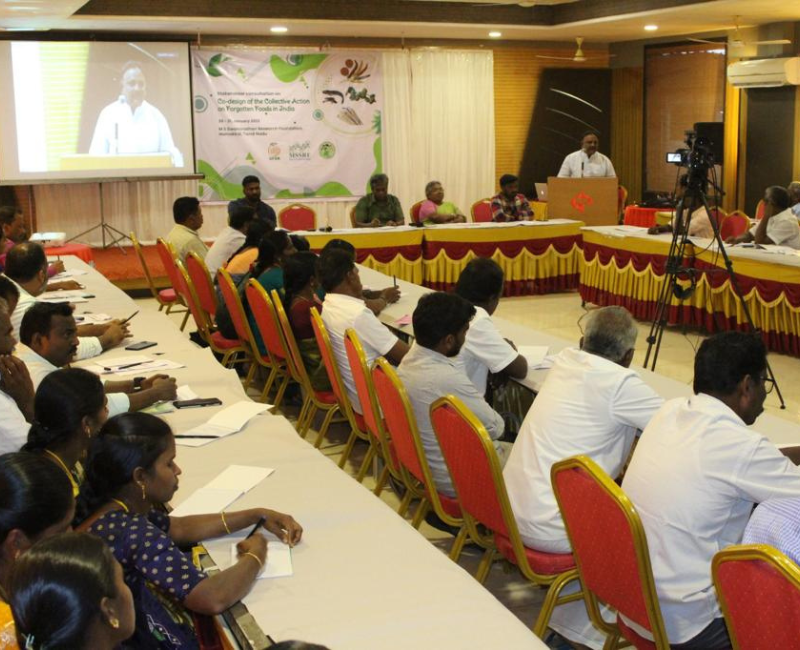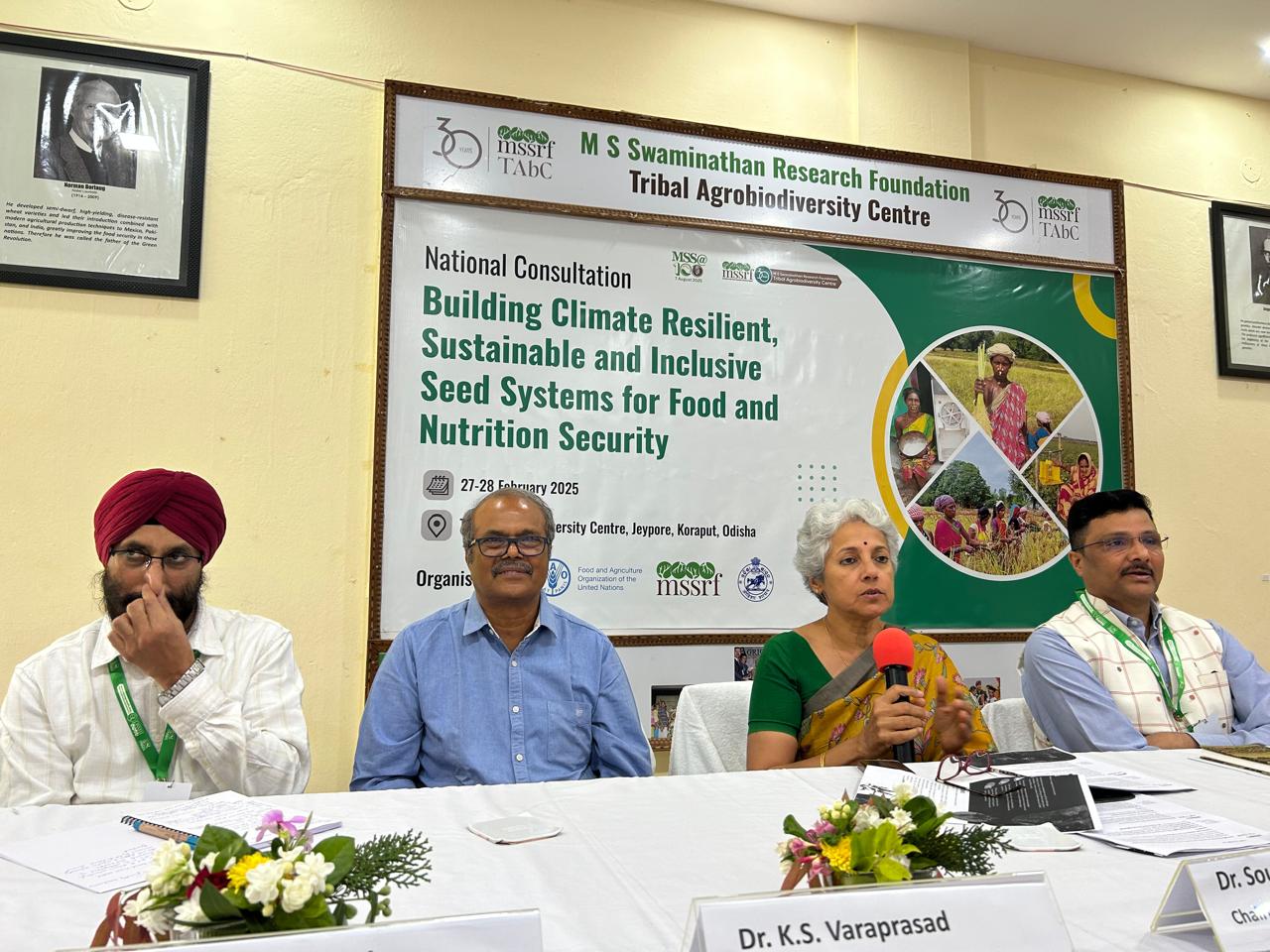The research that is part of the co-design stage of the Collective Action on Forgotten Food supported by the Global Forum on Agricultural Research and Innovation (GFAR), moved to the Indian state of Tamil Nadu. From 30-31 January 2023, local farmers engaged in discussions on how to bring back the food crops they lost.
“The decrease in consumption of food varieties has led to an increased number of forgotten foods in Tamil Nadu,” said Dr. A. Nirmalakumari, Professor, Plant Breeding (Millets), Tamil Nadu Agricultural University (TNAU), during the Workshop on the Co-design of the Programme on Forgotten Foods with farmers in Tamil Nadu.
The state grows five major types of forgotten foods, including: (i) cereals (apart from rice and wheat); (ii) pulses (apart from red gram and black gram); (iii) tubers, second most important crop next to meat; (iv) climbers (apart from beans and avarai); and (v) cucurbits (water vegetables). The factors that influence food consumption in this area are the crop season, time of harvest, ways of cooking, and time of consumption. Forgotten foods help mainly during drought seasons, and women play a major role in their conservation.
The workshop participants from Tamil Nadu worked in four different groups of farmers based on the landscape that they belong to and their gender. These landscape divisions included farmers from ecosystems, such as hills, rainfed, river and coastal areas.
Firstly, the participants worked on identifying their preferred forgotten food and how they are being used, based on which they developed a catalogue on priority forgotten foods. The outcome was a collection of all forgotten food crops, such as cereals, pulses, greens, vegetables, fruits and animal foods, as well as recipes. The participants jointly categorised and catalogued these priority foods, marking the rare and forgotten food. This fed into further discussions around the value chains related to these priority foods.
Learning from ancestors helps in retaining and bringing back the forgotten food crops
“The decreasing knowledge of traditional foods among younger generation, especially in the context of climate change, is becoming an issue,” said Mr. Pius Rance, Executive Director, North East Slow Food and Agrobiodiversity Society (NESFAS), Meghalaya, India.
Therefore, traditional knowledge on forgotten foods, as well as on climate change and nutrition, has to be collected from farmers and transferred to younger generations. It needs to be supported by science and technology, and brought back to the communities and value chain.
The world’s population only uses 30 per cent of its edible plants
Prof. D. Narasimhan, Member, State Biodiversity Board, Tamil Nadu on ‘Forgotten Foods-Status and Concern’, delivered a special lecture to the farmers. Explaining the history of agriculture since it developed 12,000 years ago, he emphasized its evolution from hunting and gathering towards crop cultivation to produce food. “Agriculture has reduced the diversity of the crops,” said Prof. Narasimhan.
The Earth has nearly 10,000 edible plants, of which people use almost 3,000, with only 150 cultivated species. Rice and maize alone supplies 60 per cent of global foods. Factors that lead to forgotten crops include lack of knowledge on greens and their processing methods, which have decreased the greens’ diversity.
Market and value chains determine knowledge and diversity of food crops. Local foods, such Palmyrah, has more than 800 uses, such as the fruit panampazham and the tuber panang kizhangu.,”
2023 – International year of millets
Dr Nirmala Kumari, Former Head, Centre of Excellence on Millets, TNAU, also delivered a special lecture focused on seed production, especially of millets and their availability. New varieties of millet, such as the white ragi, are in the pipeline in the Athiyandal Millet Research Station of TNAU.
The main benefits of millets are that they are nutritious, require less water and fertilizers, and are suitable for organic farming. Important cultivars of millets include, e.g. pearl millet, ragi, samai, thinai, pani varagu, varagu and kuthiraivaali.
Root exudates from millets promote growth of other crops, which also makes them suitable and beneficial for intercropping. The biggest challenge of millet production is marketing, quality through community seed banks, and its intensification.
Tribal people and forgotten foods
Mr. Girigan Gopi, MS Swaminathan Research Foundation (MSSRF), Community Agrobiodiversity Centre (CABC), Kerala, shared the role and experiences of tribal people in the conservation of forgotten crops. In Wayanad, Kerala, tribal people dwell inside the forest and collect about 60 wild varieties of edible green leaves, and 40 varieties of fruits, in addition to eggs, diverse mushrooms and honey.
However, these tribal people now cannot enter the forest as before, due to degradation and entry restrictions. Traditional crops, such as paddy, are decreasing because of non-profitability and lack of interest among the younger generation. Hence, the area relies on rice import from Tamil Nadu and Andhra Pradesh.
Rice fields are being converted into banana plantations, creating socio-economic problems. Cultivation of traditional varieties decined from 80 to 12 per cent between1980 and 2000. Important rice in Wayanad includes Navara rice, known for treating arthiritis, and Kanthagasala rice, known for its aroma, which is resistant to pests and diseases, as well drought and floods.
CABC-MSSRF has collected over 35 varieties of traditional seeds, which is conserved at the germplasm bank, MSSRF, Chennai. Seed exchange amongst local villagers is promoted through seed festivals (melas). An alternative seed system has also been created through Rashtriya Krishi Vikas Yojana (RKVY), Government of India, with supported participatory yield enhancement trials.
In Gujarat, India, tribal people cultivate millets, such as Ragi and some exotic fruits, but they lack the market where to sell their produce. The key forgotten crops are cholam and sorghum. The Self-Employed Women Association (SEWA) supports farmer training in production, value addition and marketing, including related to millets.
“When organic practices, technology use and community engagement is combined, millet production brings up good productivity,” said Mr. R. Sivalingam, Lead Farmer from Dharmapuri region, emphaising the importance of community farming in millet production.



